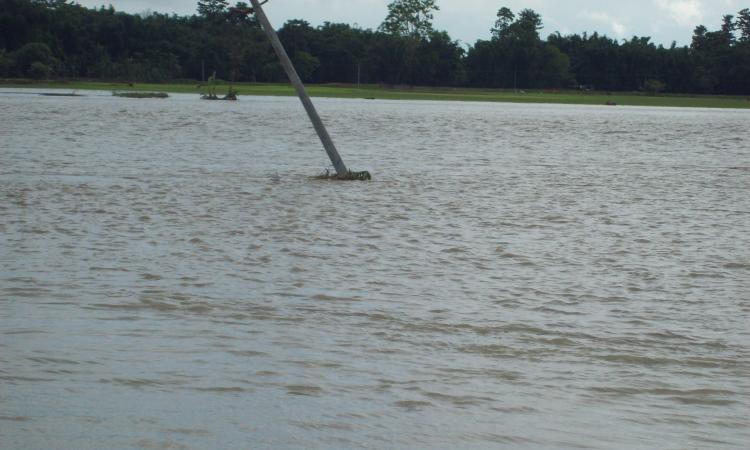
Floods in Bihar have acquired menacing proportions following the embanking of its rivers, which has led to severe dislocations in the society. Estimates suggest that 70% of the population in north Bihar lives under the recurring threat of flood devastation (1). The 2013 floods affected more than 5.9 million people in 3768 villages (2). Planners do not take notice of these aberrations owing to massive embanking. A myth has been created that the problem of floods and its solution is a purely technical one, and should be handled only by those who are technically competent.
Dinesh Mishra in a bi-lingual booklet titled 'Floods despite dams' (English) and 'Barh to phir bhi aayegi' (Hindi) explodes this myth and wants the issue of floods to be widely debated.

North Bihar, which is interspersed with eight major river basins, has a heavy concentration of flood-affected people over a small area. All these rivers that drain into the Ganga bring a lot of eroded material from the Himalayas, which is still in a nascent stage of formation and is just a loose heap of soil. These rivers erode the soil very easily and transport it to the plains. As the rivers descend down to the plains, the low velocity decreases considerably, which results in the deposition of these sediments and formation of the delta. The deposited sediments acts as an impediment to the rivers flood waters and the rivers cut across these deposits, carve a new path for themselves and meander on.
Mishra notes how just as both the arguments- for and against the embankments- are thoroughly convincing, engineers use them to justify or discard a scheme depending on the prevailing social and political compulsions. Since their views are a technical matter, it cannot be challenged by lay persons. The ghost of big dams has also been haunting the planners and whenever there is a heavy flood in Bihar, no time is lost in proclaiming that the solution to the flood problems of Bihar lies in the High Dam on the Kosi. People are repeatedly told that the Kosi embankments are only a temporary solution to the problem faced by them and that the real solution lies in the Barahkshetra dam in Nepal. "Flood control will be the plank of publicity for the dam whereas the real aim will be power generation", notes Mishra.
In the end Mishra says that it is necessary to give a whole new look to the problems that we face. "Instead of depending on the proposed large dams, should we not think of dealing with the floods locally and delink the flood problem from the proposed dams, once and forever, because such dams have never controlled the floods in past, nor will they be able to it in future. So far, only a lip service has been paid to the concept of 'living with the floods'. Can we shed the arrogance of controlling everything that comes our way and, instead, live in peace with it? Can we think of 'flood tolerant houses' instead of ‘flood resistant houses’ and can’t we think of ‘flood tolerant cropping pattern’ instead of ‘flood resistant crops? If these questions can be answered in the affirmative, our attitude towards floods will change and the large dams will come in for a scrutiny by the common people".
Reference
(1) Flood management information system - History of floods in Bihar
/articles/floods-despite-dams